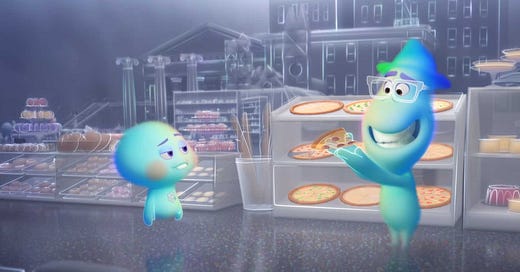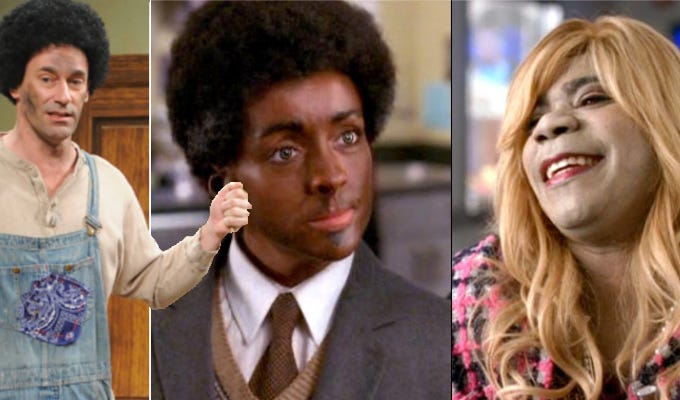UPDATE: I have edited this to reflect that Graham Norton is based in the United Kingdom, not born there. Apologies for the error.
It’s been a couple of months since I saw Soul for the first time. I liked it, and admired its originality, but would have been lying if I said it was as strong or emotionally intense as Up or Inside Out. And I largely understood why my reaction was held back slightly. I waited, and have waited, to discuss why.
That’s mostly because I figured someone else would get there first, that there would be a thinkpiece or a slew of thinkpieces related to a specific turn in the film. At least there have been tweets like this.
And this one, too.

The reactions are extremely positive from most sectors of the online world. But not a lot of criticism, and certainly not many thinkpieces. (It’s early yet, perhaps, but we’re now more than two weeks out from its release.)
So, the eponymous question: is it not weird that Tina Fey’s voice comes out of a Black man’s body for a good chunk of Soul?
As a brief overview, Soul is about Joe Gardner (voiced by Jamie Foxx), a middle-school band teacher in New York City who starts the film by being offered a full-time teaching position that he clearly would rather not accept. No, Joe wants to be a jazz musician, and he soon gets the chance to play with a jazz legend thus achieving his dream. And then he immediately falls into an open manhole and dies.
Joe wakes up on the staircase to the Great Beyond, and instead of finding out what’s on the other side, he escapes to the Great Before. That’s the holding place for incoming souls who need to find their “spark” to head to Earth. Joe ends up as the Soul Mentor for 22 (Fey), a soul who refuses to go to Earth because it thinks there’s no purpose in living. Joe and 22 team up to get him back into his body, which is fine…until 22 winds up in Joe’s body and Joe winds up in the body of a cat.
For roughly 25 minutes, the Joe the human world encounters isn’t really Joe, it’s 22 in Joe’s body. And whenever “Joe” is talking, we’re either hearing Foxx or Fey as. The purpose is simple: 22 doesn’t believe in the worthiness of pursuing life on Earth, until they almost literally walk a mile in Joe’s shoes, finding great joy in the small things from a half-eaten bagel to a subway card.
It would be unfair to say that we only hear Fey as “Joe” during this section. We do hear Fey’s voice while we see “Joe”, though, and the film has already established that 22’s voice is that of a “middle-aged white lady”. There are two inherent problems : the problem of hearing a white woman’s voice coming out of a Black man’s body, and the problem of hearing Tina Fey’s voice coming out of a Black man’s body.
Tina Fey’s history with race is…uh…Not Great, Bob. If you like, you can applaud her for pushing to remove moments of blackface from four episodes of 30 Rock. I would point out that it’s grim that there was blackface on four episodes of 30 Rock, a show that aired in the 21st century on a major television network. And that’s to say nothing of the racial issues surrounding Unbreakable Kimmy Schmidt. Fey’s joked about it before, but she’s also struck a discordant note when talking about issues that boil down to race, such as her Charlottesville riff on Saturday Night Live. There are far worse white women who could’ve been cast as 22. But…why cast any white woman as 22?
As the film establishes, 22 could sound like a child or a grouchy old man or even Joe himself. (When 22 demonstrates this, their body morphs to look and sound exactly like Joe, which is slightly weird, but only slightly.) 22, thus, could have been portrayed by anybody. There’s no shortage of Black actresses who have distinctive enough voices to handle the work of this script. (Prior to Soul, four Black actresses have had moderately sized parts in Pixar films: Jenifer Lewis in Cars, Whoopi Goldberg in Toy Story 3, Kerry Washington in Cars 3, and Octavia Spencer in Onward.)
There are many things I liked about Soul. (I gave it a B+ in my review.) The animation is genuinely remarkable, a bold step forward for Pixar after 25 years of establishing itself as the gold standard of computer animation. There’s one particular moment, just after the brief opening credits, where Joe is falling from The Great Beyond to The Great Before, that I could’ve watched for an hour. The animation there is distinctive and strange and boundary-pushing. Foxx is well-cast as Joe, grappling with a mid-life crisis in part while he’s not even alive. But I only liked the film, largely because of that middle section.
Joe learns more about his own life by watching 22 live it, which might work better…if, say, a scene at the local barbershop didn’t have us hearing a white woman figure her way through the process of getting a haircut and learning more about the barber than Joe ever did while he was alive. I get the function of scenes like this. But it’s jarring, uncomfortable, and arguably unnecessary for this character to be voiced by a white woman.
Soul deserves credit for being one of the most diversely cast films in Pixar’s filmography. Aside from Coco, there’s just this movie in terms of offering majority non-white representation. And the issues with Fey aside, there’s only one major role in the film voiced by a white man. (As an aside, it delights me that when Pixar crossed the inevitable rubicon of casting a U.K.-based talk-show host for a major role, they cast…Graham Norton. Not Mr. Corden.) For a studio that skirted serious criticisms for a long time for its lily-white casts, this is a big step forward.
Which is why hearing Tina Fey’s voice come out of a Black man felt like a step back at the same time.
I have an Amazon Fire TV in my bedroom. At night, if I’m holding my year-old son to rock him to sleep, I have the TV’s home page on without watching something. Lately, the major screensaver is a promotional image from Soul, of Joe and the cat smiling out at the audience. (It’s not dissimilar to the image above this paragraph, but not the same one.) Every time I look at that image, it troubles me. Which Joe am I looking at? The cat only has serious screen time when it’s possessed by Joe. So…is the big promotional image one of characters who are race-reversed? I don’t know. But it’s uncomfortable to me, in part because I’m not sure the film has fully wrestled with the meaning of all of this.
I pose the question at the top, though, because I’ve only seen a handful of people talking about it. The enviably excellent Justin Chang called it out in one of his Slate Movie Club entries. There have been tweets like those above. But the lack of a more detailed pushback has kind of thrown me.
Yet I must wrestle with the reality that by essentially saying “Why aren’t more people talking about this?”, I am really saying “Why aren’t more of the critics and writers I follow online talking about this?” Which is a problem with who I read and pay attention to, as much as it’s an issue of the discourse. If the critics I respect aren’t talking about issues of race in Soul, I haven’t cast my net wide enough.
I was glad to see this thread of comments and reviews tallied by Anya Stanley, even as it emphasizes the grim reality that there are far too few people of color writing about a film that is so specifically about people of color and their life experiences.
Anyway. There’s a lot going on in this newsletter, I realize. The upshot is: I wanted badly to love Soul, and I think parts of the movie are excellent. But I can’t get over a misguided storytelling choice informed by casting a white woman in such an unexpectedly charged role.












Graham Norton was born in Ireland, not the UK.